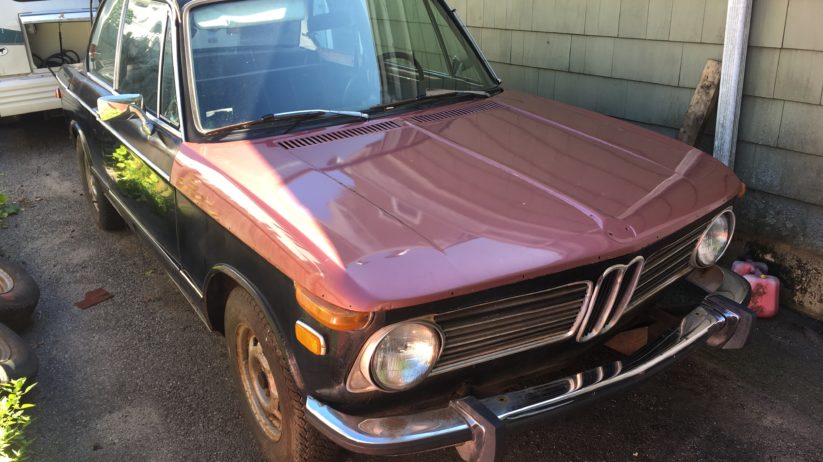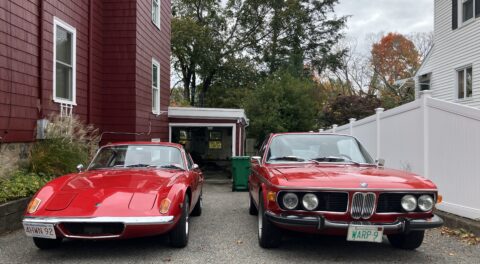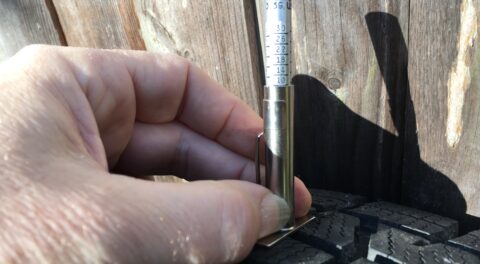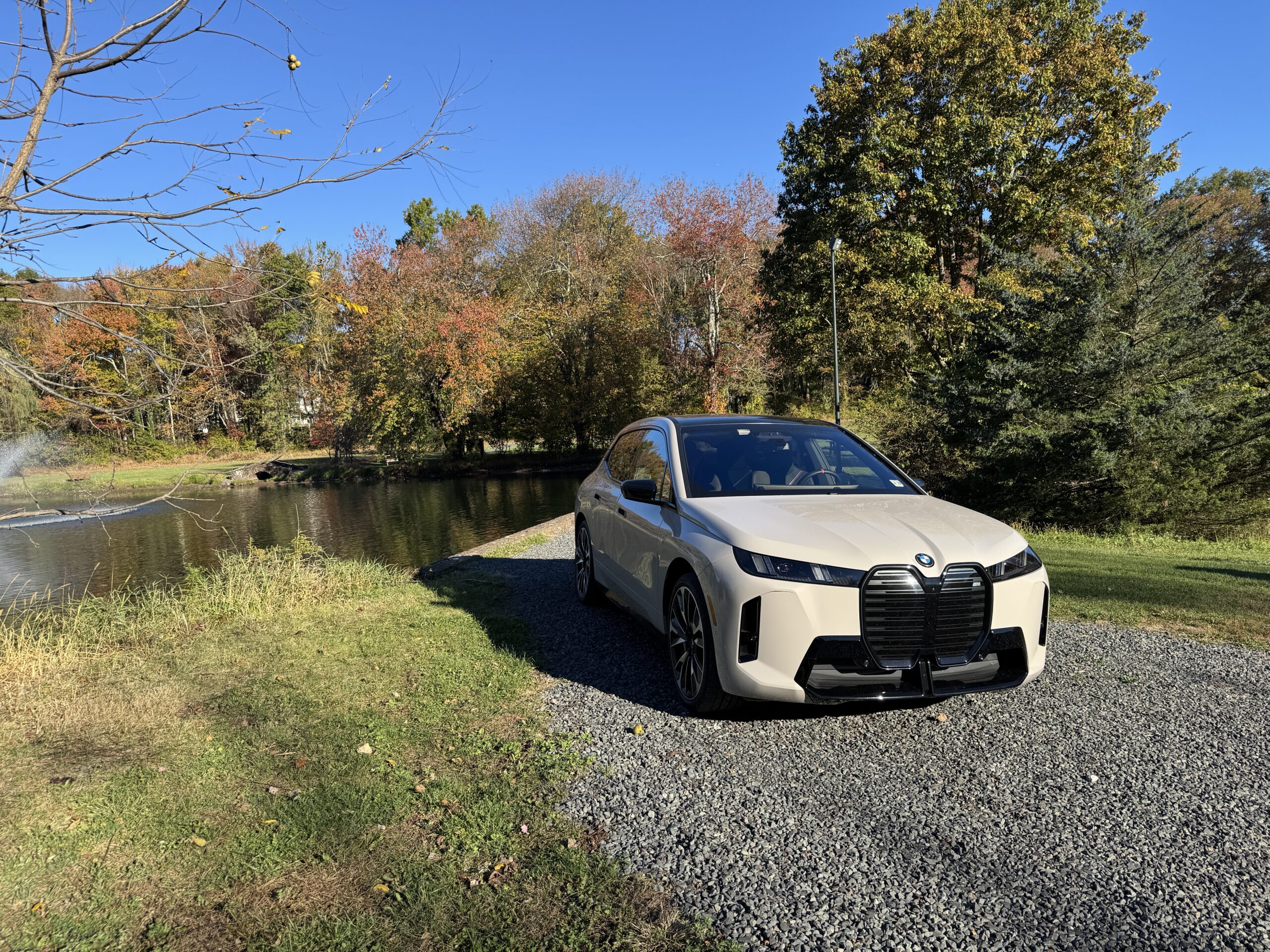This will probably be the final piece in this series describing my foster parenthood of “The Faux Tii,” the 2002 into which someone had transplanted a tii injected engine, braking system, and dashboard clock. The car was so rusty and ratty that it was clearly a parts car, but I didn’t really need the high-value parts (the injected engine and the tii strut housings), and the work required to part out the car and dispose of the hulk was more than I wanted to go through. I decided to get it running so I could evaluate and document the condition of the engine, which, after all, was the most valuable part, and then sell it as a whole car (“a running tii engine in a 2002-shaped transportation container”) and let the next owner decide what to do with it. I mean, just because I don’t think that a 2002 is salvageable doesn’t mean I should condemn it to death.
Last week, by completely bypassing the car’s booged-up wiring and getting the engine started and running on only four wires, I achieved that goal. I found that the engine, which had an eat-off-it clean valve train that included a Schrick cam, had fairly even compression centered around 150 psi, ran well, didn’t smoke, and put out a good strong even exhaust putt-putt-putt.
With the goal of getting the engine running and documented complete, I began to think about what was necessary to ready the car to move it along. But first, I, well, ahem, snatched a few things. Spoils of war and all that.
The car came to me wearing a set of rusty but authentic 5″-wide tii steel wheels. Because of the tii’s bigger front calipers, it needs 5″-wide wheels on the front. Thus, in ’72 and ’73, when all other 2002s had solid 4.5″ wheels, tiis had five-inchers. Beginning in ’74 with the big-bumpered square-taillight cars, all 2002s got 5″-wide slotted steel wheels. So the solid 5″-wide wheels are quite rare. The ones on the faux tii were in awful condition, but I grabbed them, swapping them for one of several sets of later slotted wheels gathering moss at the end of my driveway.
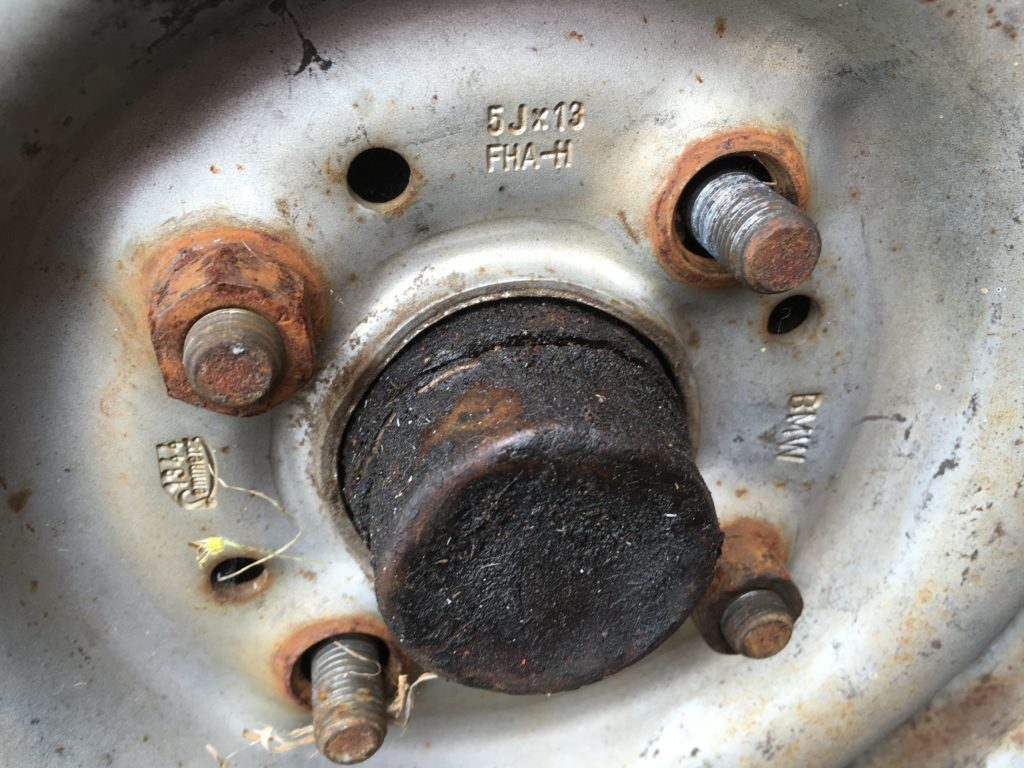
The authentic tii 5″-wide steeliies were worth grabbing.
There were a set of small Hella driving lights on the front bumper. My ’72 tii Kugel originally had a set on hers, but the reflector on one of them rusted, making it look like the car had a black eye, so I pulled these off and installed them on Kugel. I snagged the vintage Momo Jackie Stewart steering wheel the car was wearing, and replaced it with a BMW padded wheel I had left over from a big-bumpered car. Lastly, the chrome in the center section of the faux tii’s rear bumper was much shinier than that of Kugel’s, so I pulled the bumper off, intending to disassemble both and make one shiny one for Kugel and one less-than-shiny one for the faux tii. Unfortunately, I got stymied by the frozen bolts holding on the bumper brackets. The jury is still out on this.
But, to even out the bumps on the big circle of life, I did a few things to make the car look complete as opposed to picked-over. When it came to me, it had a replacement hood from another car bungied in place. Obviously I’d slid it off to work on the engine. With help from two of my kids who were in town for the weekend, I bolted it to the hood hinges so it could be raised and lowered easily. Next I re-installed a headlight I’d borrowed to get another one of the cars inspected, then attached the front grilles, which had been living in the trunk. Suddenly the faux tii had a face, and faces make cars look whole.
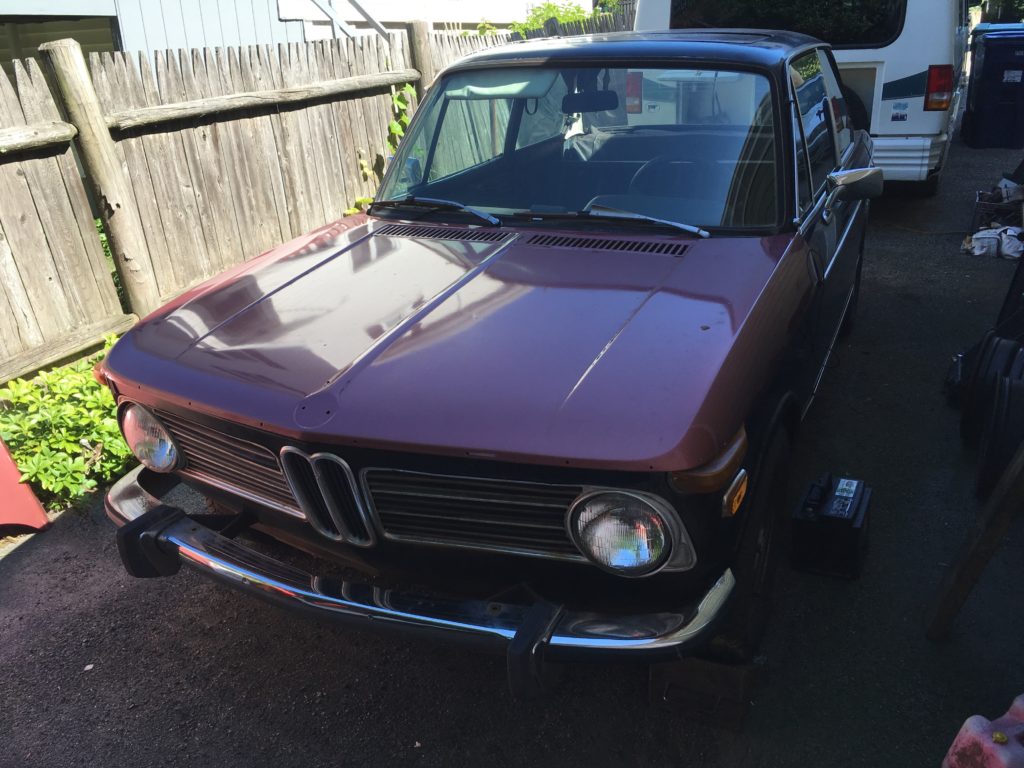
There. That doesn’t look so bad.
Back in May, I’d pulled out the instrument cluster in search of a speedometer with a working odometer that I could throw into Bertha prior to her trip to the Vintage. I’d found that the faux tii’s odometer didn’t work either, but had never replaced the cluster. I reinstalled it, making the dash look complete. In addition, the car was missing its center console. I had a spare one kicking around in the garage, left over from Bertha’s parts hoard. I sat it on the transmission hump. The instrument cluster and console helped, but much of the car’s interior missing, having only a driver’s seat and no door cards.
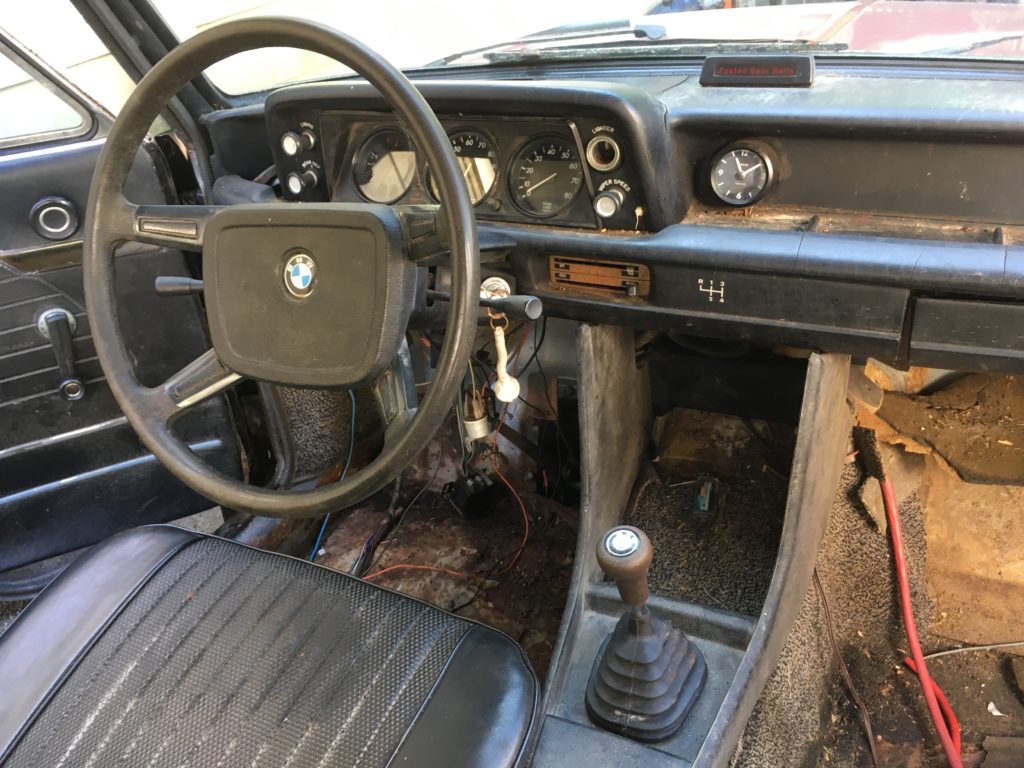
It almost looks like you could drive it.
Bertha’s parts hoard also contained a set of door cards in poor condition. I donated them to the cause so the car’s inside didn’t look quite so much like a construction zone.
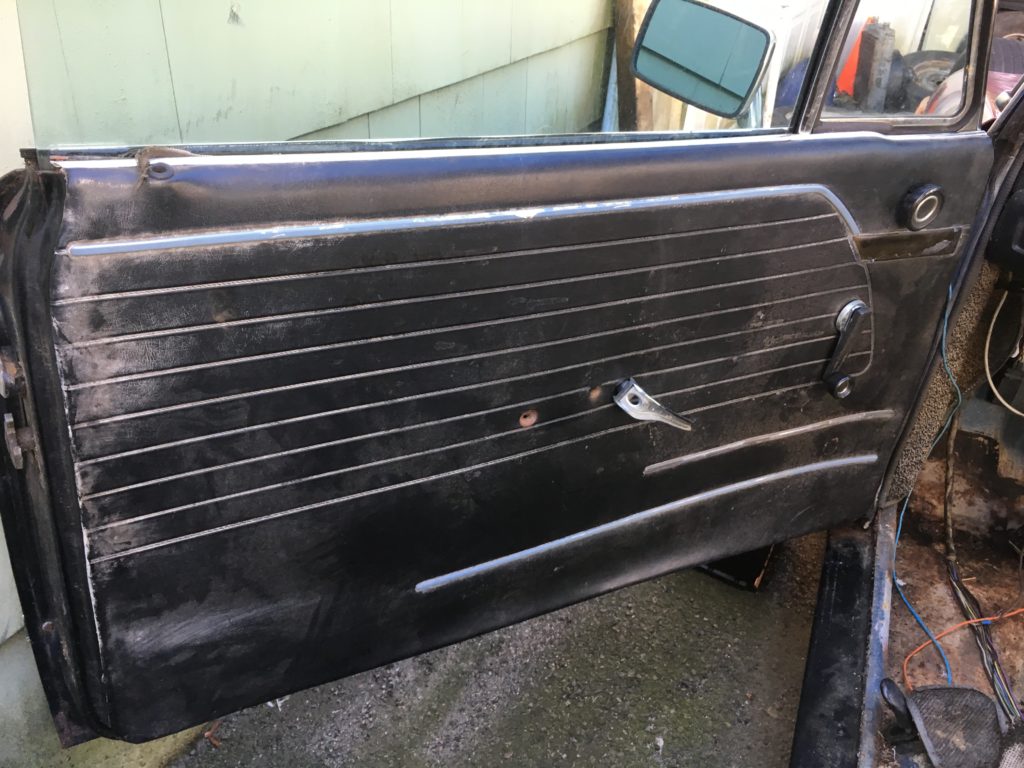
Even a bad door card is better than none.
As I said, all of this was to make the car look better and more whole for sale, but I began to think. Quite a few dead cars have crossed my path the last five years, from the Turkey to Louie to Old Blue to Bertha to the Lama to the Lotus. Resurrecting dead cars is what I do. I’d revived this one’s engine, but all the car had gotten the chance to do was wake up and look around my driveway; it hadn’t run off into the woods (or, more properly but less prosaically, drive down the road) to experience the joys of existence. I recalled how wonderful it was to go through this experience with all these cars and reach the point where they’re among the living and driving. I fondly recalled the similar situation with Old Blue, the ratty long-dead tii that, like this one, turned out to have a modified engine with a hot cam and a whistle-clean valve train, and how, when I nailed it for the first time, I found that it was the fastest tii I’d ever driven. I began to wonder if I’d find the same thing out with the faux tii. But I’d never know unless I went further and got it driveable. Nothing ventured, nothing gained.
So I began testing the waters of a larger resurrection.
The immediate issue was that the car didn’t have a functional clutch; the pedal lived all the way down on the floor. This seemed to be caused by two issues. The first was that the spring on the pedal didn’t appear to be installed correctly, so it wasn’t helping the pedal return to the up position. The second was that the level of the brake reservoir was lower than the feed to the clutch master cylinder, indicating that the clutch hydraulics were leaky. I filled the reservoir up, and didn’t see fluid streaming out anywhere. Since the spring wasn’t working, I grabbed the pedal with my hand and pumped it up and down about thirty times, but felt no resistance building.
The next step was to try a proper bleeding, and that’s where it all ground to a halt. I jacked up the car, set it on jack stands, crawled beneath it, put a 7mm wrench on the bleed valve on the slave cylinder, tried to open it, and the valve snapped right off.
Now, I don’t necessarily believe in omens. For mechanical issues, I usually think “Omens? I’ll make yer omens bend to my iron Hack Mechanic will.” But I’m a practical guy. The slave cylinder is about $70, the master about $90, and neither are 20-minute jobs to replace. The slave is held to the transmission bell housing by a pair of snap rings, but once they’re removed, it’s common to find the steel slave held fast inside its hole in the housing due to 45 years of corrosion of dissimilar metals. It often requires heating, beating, twisting, and a steady stream of blue language to get it out. Then, installing the replacement slave requires taking off the lock ring, rubber boot, and push rod, putting these in place at the clutch release fork, putting one snap ring on the slave, sliding it through the back of the hole in the bell housing, aligning the pushrod against the piston inside the slave, and pushing against the back of the slave with one hand so the pushrod makes the piston retract, while installing the second snap ring with the other hand. The master cylinder is rarely rusted in place, but it’s attached to the firewall with nuts and bolts, making it difficult for one person to do the job alone. And one of the nuts is difficult to get a wrench on. So, no, I didn’t really regard the snapped bleeder valve as an omen, but when it happened, I almost instantly thought “Damn! Resurrection’s waters are cold!” and hightailed it back to shore.
I did a walk-around video of the car and posted it, along with the video of the engine running and a few other pics, on Facebook. Later that day, I got a phone call from a fellow named Connor. He reminded me that, a few years prior, I’d looked at a ’74 tii he and his dad were parting out. His dad owned an Inka ’73 tii that had been off the road for decades. Connor, who has welding skills, said he was thinking about buying the faux tii, patching the floors enough to drive it around for a while, and then, when the time came, part it out to help in the resurrection of his dad’s car.
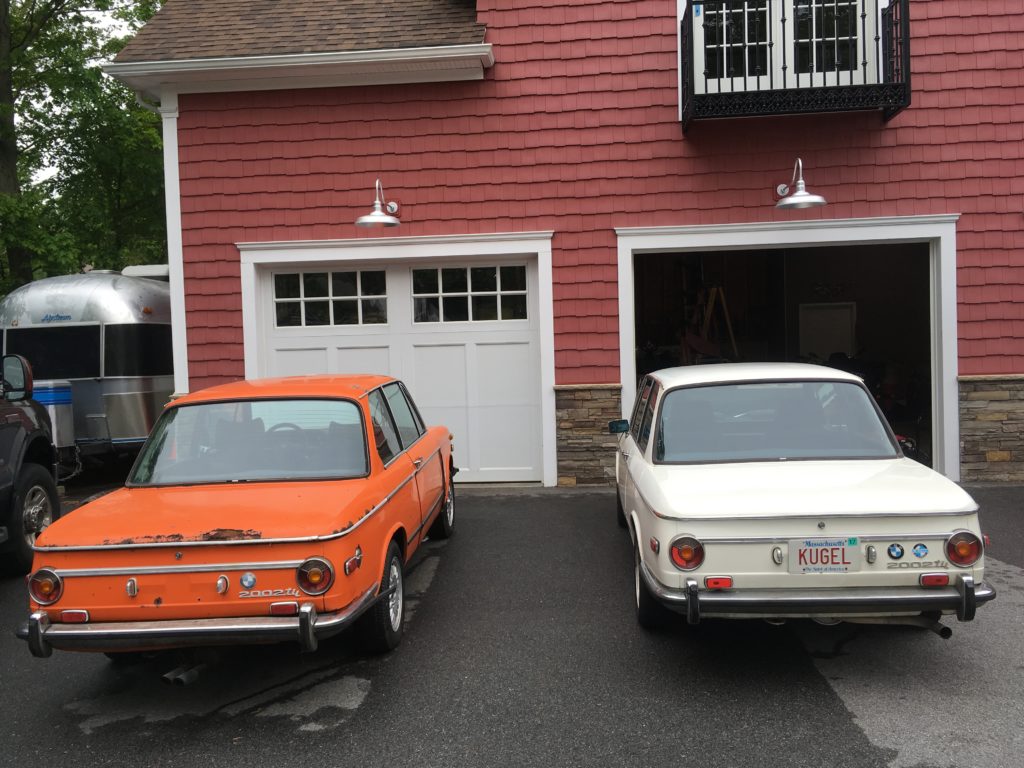
Kugel and Cameron’s dad’s ’73 tii a few years back.
That evening, Connor came over and looked at the car. I showed him the good (the engine running), the bad (the booged-up wiring), and the ugly (the patch job on the floors). He went home, he and his father conferred about it, and the next day, we struck a deal. As part of it, I did some sorting-out on the electrical system, removing some dangerous and inactive wiring, securing some of the active but dangling stuff, and making it so the car could be started conventionally with the key (although the battery still has to reside on the fender, as the battery tray has been removed). I also got the cold start injector wired to a switch next to the steering wheel. There already was a switch wired in, but it was broken. I kept assuming it was the wiring; it took me longer than it should’ve to figure that one out.
I don’t think I could’ve hoped for a better fate for the faux tii.—Rob Siegel
Rob’s most recent book, Just Needs a Recharge: The Hack MechanicTM Guide to Vintage Air Conditioning, is available here on Amazon. His previous book Ran When Parked is available here. Or you can order personally inscribed copies of all of his books through Rob’s website: www.robsiegel.com. His next book, Resurrecting Bertha: Buying Back Our Wedding Car After 26 Years In Storage, will be released in the fall.

